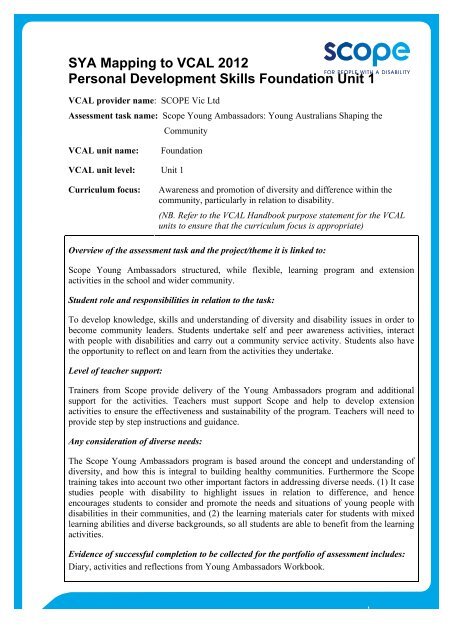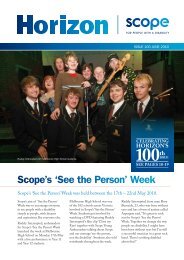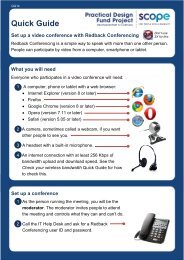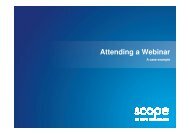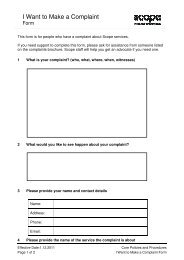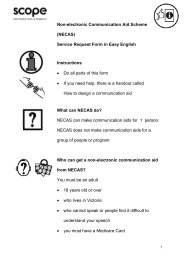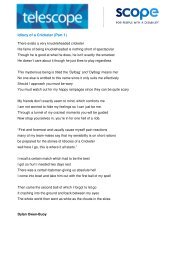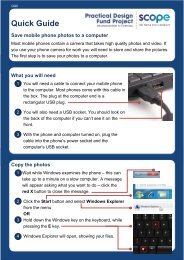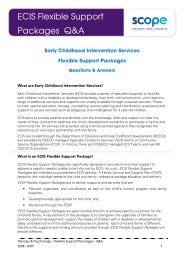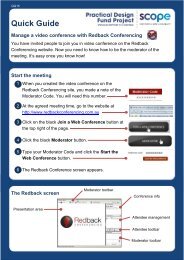Personal Development Skills Foundation Unit 1 - Scope
Personal Development Skills Foundation Unit 1 - Scope
Personal Development Skills Foundation Unit 1 - Scope
- No tags were found...
You also want an ePaper? Increase the reach of your titles
YUMPU automatically turns print PDFs into web optimized ePapers that Google loves.
SYA Mapping to VCAL 2012<br />
<strong>Personal</strong> <strong>Development</strong> <strong>Skills</strong> <strong>Foundation</strong> <strong>Unit</strong> 1<br />
VCAL provider name: SCOPE Vic Ltd<br />
Assessment task name: <strong>Scope</strong> Young Ambassadors: Young Australians Shaping the<br />
Community<br />
VCAL unit name:<br />
<strong>Foundation</strong><br />
VCAL unit level: <strong>Unit</strong> 1<br />
Curriculum focus:<br />
Awareness and promotion of diversity and difference within the<br />
community, particularly in relation to disability.<br />
(NB. Refer to the VCAL Handbook purpose statement for the VCAL<br />
units to ensure that the curriculum focus is appropriate)<br />
Overview of the assessment task and the project/theme it is linked to:<br />
<strong>Scope</strong> Young Ambassadors structured, while flexible, learning program and extension<br />
activities in the school and wider community.<br />
Student role and responsibilities in relation to the task:<br />
To develop knowledge, skills and understanding of diversity and disability issues in order to<br />
become community leaders. Students undertake self and peer awareness activities, interact<br />
with people with disabilities and carry out a community service activity. Students also have<br />
the opportunity to reflect on and learn from the activities they undertake.<br />
Level of teacher support:<br />
Trainers from <strong>Scope</strong> provide delivery of the Young Ambassadors program and additional<br />
support for the activities. Teachers must support <strong>Scope</strong> and help to develop extension<br />
activities to ensure the effectiveness and sustainability of the program. Teachers will need to<br />
provide step by step instructions and guidance.<br />
Any consideration of diverse needs:<br />
The <strong>Scope</strong> Young Ambassadors program is based around the concept and understanding of<br />
diversity, and how this is integral to building healthy communities. Furthermore the <strong>Scope</strong><br />
training takes into account two other important factors in addressing diverse needs. (1) It case<br />
studies people with disability to highlight issues in relation to difference, and hence<br />
encourages students to consider and promote the needs and situations of young people with<br />
disabilities in their communities, and (2) the learning materials cater for students with mixed<br />
learning abilities and diverse backgrounds, so all students are able to benefit from the learning<br />
activities.<br />
Evidence of successful completion to be collected for the portfolio of assessment includes:<br />
Diary, activities and reflections from Young Ambassadors Workbook.<br />
<br />
1 <br />
scopevic.org.au
LEARNING OUTCOME 1<br />
Plan and organise a simple activity.<br />
Description of what the student will be required to do in order to demonstrate<br />
successful completion of the learning outcome:<br />
The student will plan and implement the activity to achieve the goal defined by the<br />
<strong>Scope</strong> educator:<br />
After the student has developed his/her understanding of disability issues, through<br />
gaining an historical overview and learning about barriers for people with disability<br />
through a reading comprehension, he/she will carry out a wheel chair friendly survey<br />
with his/her peers, and make recommendations based on this survey.<br />
Elements<br />
The elements are demonstrated when the student can: <br />
1.1 Develop a plan for a simple activity in relation to one or more of the <br />
following: <br />
self, social, health and well being, education and/or family, <br />
1.2 Plan for the activity that involves a limited number of steps within a defined <br />
period of time. <br />
1.3 Select resources appropriate to carrying out the plan. <br />
1.4 List criteria for achievement and carry out the planned activity <br />
1.5 Reflect upon the personal achievements and challenges of the activity <br />
LEARNING OUTCOME 2<br />
Demonstrate knowledge specific to an simple activity or goal.<br />
Description of what the student will be required to do in order to demonstrate<br />
successful completion of the learning outcome:<br />
After reading and reflecting on information about disability issues (through an<br />
historical overview presentation, reading comprehension, learning about <strong>Scope</strong><br />
services and different types of disability), the student will use this information to<br />
decipher the definitions of the 1986 Australian Commonwealth Disability Services<br />
Act through a written exercise. The student will also complete a comprehension<br />
exercise related to the different types of disability, thus broadening his/her knowledge<br />
of disability and difference.<br />
The student will have the opportunity to reflect on his/her own performance through<br />
sharing his/her definitions of the Disability Act and comprehension answers with<br />
his/her peers.<br />
Elements<br />
The elements are demonstrated when the student can: <br />
2.1 Identify knowledge that will contribute to the achievement of an activity or <br />
goal. <br />
2.2 Access and gather information required to complete an activity or goal. <br />
2.3 Interpret information to predict steps required for completion of an activity <br />
or goal. <br />
2.4 Reflect on own performance and outcomes achieved <br />
<br />
2
LEARNING OUTCOME 3<br />
Demonstrate skills specific to a simple activity or goal.<br />
Description of what the student will be required to do in order to demonstrate<br />
successful completion of the learning outcome:<br />
The student will learn how to communicate more effectively with people who have a<br />
disability by learning the alphabet in sign language. He/she will practise the newly<br />
acquired skills through a decoding written exercise and sharing with peers.<br />
Elements<br />
The elements are demonstrated when the student can: <br />
3.1 Identify personal and other skills that will contribute to the achievement of <br />
an activity or goal. <br />
3.2 Demonstrate use of skills relevant to an established activity or goal. <br />
3.3 Use and comply with occupational health and safety guidelines. <br />
3.4 Use specified technological equipment and materials proficiently to suit the <br />
conditions and the level of individual ability. <br />
LEARNING OUTCOME 4<br />
Solve problems specific to a simple activity or goal.<br />
Description of what the student will be required to do in order to demonstrate<br />
successful completion of the learning outcome:<br />
The student will participate in activities where disability issues are explored and then<br />
demonstrate consideration of what they have learned in the context of their<br />
environments (ie. class and school). After developing an awareness about disability<br />
issues, including barriers related to the environment and people’s attitudes, the student<br />
will imagine how a new classmate with cerebral palsy should be welcomed into<br />
his/her class. So he/she will first be asked to identify the problems and issues facing<br />
people with disabilities, and then look at ways to solve those problems through a<br />
hypothetical, personalised situation.<br />
This will be an interactive exercise, where the student will give opinions/ideas and<br />
also learn about his/her peers’ opinions/ideas. This process will also involve the<br />
student receiving feedback about his/her ideas, and giving feedback to his/her peers<br />
about their ideas in a constructive way.<br />
Elements <br />
The elements are demonstrated when the student can: <br />
4.1 Identify an issue or social problem related to an established activity or goal. <br />
4.2 Explain possible solutions to the problem identified. <br />
4.3 Contribute to an activity that is aimed at resolving the issue or social <br />
problem. <br />
4.4 Reflect upon the effectiveness of the action taken to resolve the issue or <br />
social problem. <br />
LEARNING OUTCOME 5<br />
Demonstrate teamwork skills.<br />
<br />
3
Description of what the student will be required to do in order to demonstrate<br />
successful completion of the learning outcome:<br />
The student will demonstrate teamwork skills in the classroom activities through:<br />
• Practising his/her communication skills with his/her peers (survey, sign language<br />
exercise),<br />
• Sharing ideas and information with his/her peers,<br />
• Providing feedback to peer(s)<br />
• Receiving feedback from peer(s), and<br />
• Working on exercises together in mixed ability groups.<br />
Elements <br />
The elements are demonstrated when the student can: <br />
5.1 Contribute and participate in an activity involving a group/team. <br />
5.2 Describe personal factors that contribute to group/team work. <br />
5.3 Reflect on factors that influence group/team behaviour. <br />
5.4 Discuss the effectiveness of group/team processes for achieving goals.<br />
<br />
4


